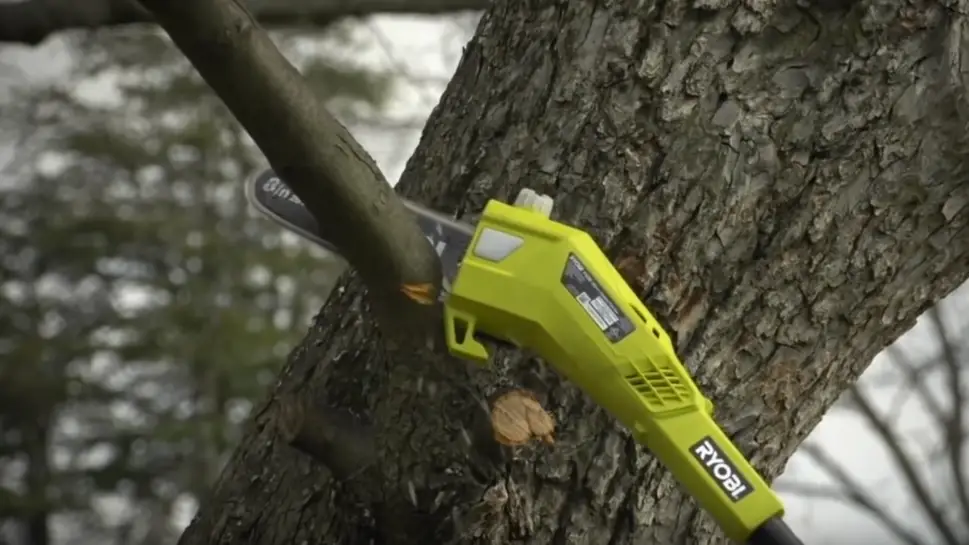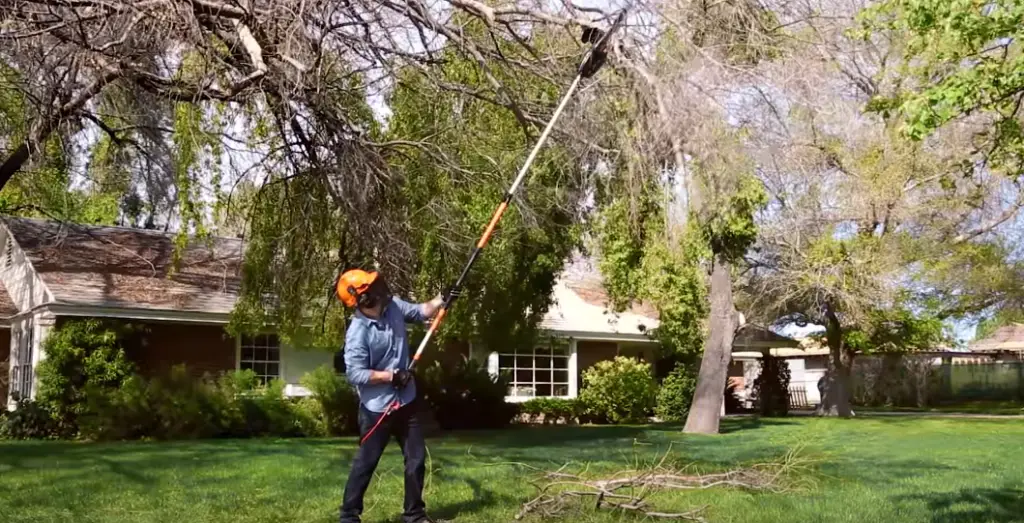Table of Contents
What is a pole saw used for
A pole saw is a special type of gardening tool designed to trim and prune the tall trees with crowns or tall decorative shrubs without using ladders. This tool will be a reliable assistant who will greatly facilitate the care of green spaces in your garden. However, at the same time, it’s worth considering that the high-quality pole saws, however, like any other excellent tools, are not that cheap.

That is why it’s very important to invest your money wisely and choose the model that will completely satisfy all your requests. First, you need to understand the tasks that you want to solve with the help of this instrument, do not forget about your physical abilities and the pool of work.
Many U.S. manufacturers design and manufacture different types of pole saw instruments. However, most of them have the same design.
The special design of a pole saw for trimming high trees
These tools look like special saws and their performance indicators are very similar to trimmers, mowing machines, shears, and chainsaws. The main differences are related to the cutting mechanism or a detachable telescopic pole that can be unfolded up to 120 inches.
The cutting mechanisms resemble an electric or gasoline chain saw. It usually consists of a moving chain and a fixed tire. The efficiency level of such a device directly depends on the parameters of the cutting details (i.e. chains and tires), as well as the engine’s power.
Different types of pole saw in the U.S. market
1) Mechanical or manual pole saws resemble ordinary garden shears, only with very long handles. The prototype of modern pole saws is a mechanical tree and bush cutter. By the way, many gardeners still use such manual tools for small trimming tasks. The two-handed pole saw resembles a large pruner with a long shaft. This shaft serves as a lever and has a pair of cutting elements – sharp knives.

2) Electric pole saw tools work on an electric motor powered from the grid through an electric cord. Their main advantages are low cost and simple maintenance. However, at the same time, the radius of their action is strictly limited by the cord’s length. The level of efficiency depends on the voltage.
3) Gasoline instruments are the most powerful models. They ignite from gasoline-based ICEs (internal combustion engines). They are designed to handle a lot of trimming tasks per session and perform particularly difficult tasks. Due to its excellent mobility (independence from the power grid and battery charging time), the gasoline tool does not have any restrictions on the location of use. It is only necessary to refuel it with a gasoline mixture.
4) Cordless pole saws, just like the previous tools, have an electric motor that is only powered by rechargeable batteries. They are not tied to the electrical grid. These pole saws are more mobile. Battery cutters stand out separately: they are similar to electric models, but their independence from an external power source and availability of fuel makes them as convenient as possible.

Gasoline, electric and cordless pole saws must be controlled by a gardener. Working with such a tool, you won’t have to make any special efforts. Therefore, I advise you to buy a pole saw for your garden. If your budget is limited or you are the owner of a small garden, you can pick up a good mechanical cutter or use a more powerful instrument.
What is pole saw used for: tips for buyers
- Estimate the difficulty and frequency of tasks. For example, you need to cut 5 trees or a large garden – it is a big difference. Keep in mind that trees with thick branches are much harder to prune than a tree of the same size, age, and volume, but with twigs and thin branches. The correct assessment of gardening tasks will allow you to choose the equipment without overpaying for it. You won’t need a powerful electric pole saw if you need to cut a few trees once a few months;
- Mobility is another important factor to consider. Even if you have only one tree, but it is large, you can’t reach the upper branches without climbing to the tree’s top. So you have to take the stairs or pull the power cable of a pole saw. In this case, a chosen instrument must be lightweight because keeping it above your head and even healing branches is not an easy task. Here, the tool’s weight will directly affect your mobility;
- Power is another essential option to look for. When working with some types of wood, it is better to have a more powerful instrument. Cutting thick branches also requires a lot of strength. And even if you only have 1-2 trees, then you will need to invest in powerful cutters. When you need to stop the growth of branches in a certain direction, for example, to prevent the leaves from falling on the backyard of your neighbors or touching the electric cables, you should pick a powerful instrument to use it once or twice per year;
- The noise level. The more noise your instrument makes, the less comfortable the work will be for your relatives and neighbors. After all, you need to look for branches at a distance of 4.4 yards. Also, keep in mind that it can vibrate on a long handle. Choose electric pole saws – their vibration is minimal as well as the noise level;
- The weight of the tool must be considered, especially if you have physical disabilities. Just think about how many pounds of metal and sharp blades you will be able to hold over your head. It is essential for both comfort and safety;
- Invest in a telescopic handle. Consider that you should cut the branches almost above your head, and they will fall vertically down. The farther you stand from the place of falling, the safer it is for you. I would recommend buying a pole saw with a long telescopic handle, otherwise, there is a risk of getting an injury increases several times;
Comparison of Pole Saws
When it comes to trimming and pruning trees, a pole saw can be a handy tool to have. There are different types of pole saws available in the market, and choosing the right one can be overwhelming. This table provides a comparison of various indicators to help you make an informed decision.
The table below compares the different types of pole saws based on their length, weight, power source, and maximum cutting diameter. The indicators are compared between corded electric, cordless electric, and gas-powered pole saws.
| Indicator | Corded Electric Pole Saw | Cordless Electric Pole Saw | Gas-Powered Pole Saw |
|---|---|---|---|
| Length | 6-10 feet | 8-12 feet | 8-12 feet |
| Weight | 7-15 pounds | 6-14 pounds | 10-15 pounds |
| Power Source | Corded | Battery | Gas |
| Maximum Cutting Diameter | 6-10 inches | 8-12 inches | 12-14 inches |
The table shows that gas-powered pole saws have the longest cutting diameter but are also the heaviest. Cordless electric pole saws are the lightest and offer the most flexibility, while corded electric pole saws are ideal for those who don’t want to worry about battery life. Overall, the choice of pole saw will depend on your specific needs and preferences.
FAQ
What are the different types of pole saws?
There are several types of pole saws available, including electric, gas-powered, and cordless models. Electric pole saws are powered by electricity and are ideal for smaller jobs around the yard. Gas-powered pole saws are more powerful and are best for larger jobs or for professional use. Cordless pole saws are battery-powered and offer the convenience of being able to use them anywhere without needing an electrical outlet.
What should I look for when buying a pole saw?
When buying a pole saw, it is important to consider the length of the pole, the power source, and the type of blade. The length of the pole should be long enough to reach the branches you need to trim, but not so long that it is difficult to handle. The power source will depend on your personal preferences and the size of the job you need to do. The blade type will depend on the type of branches you need to cut, with some blades designed specifically for pruning and others for heavier-duty cutting.
What are some tips for using a pole saw safely?
When using a pole saw, it is important to follow all safety guidelines to avoid injury or property damage. This includes wearing appropriate protective gear such as eye and ear protection, gloves, and sturdy footwear. You should also ensure that the pole saw is securely fastened and that the blade is properly tensioned and lubricated. Always keep the blade away from yourself and others while in use, and never use the saw in wet or slippery conditions.
What maintenance is required for a pole saw?
Proper maintenance of your pole saw is essential to ensure optimal performance and safety. This includes regular cleaning and lubrication of the blade, inspecting and tightening all screws and bolts, and checking the tension of the blade regularly. Refer to the owner’s manual for specific maintenance instructions for your model.
What are the benefits of using a pole saw?
Using a pole saw can make it easier and safer to trim tree branches and shrubs in hard-to-reach areas. By extending your reach with a pole saw, you can avoid the need to climb a ladder, reducing the risk of falls and injuries. Additionally, a pole saw can help you to maintain the health of your trees and shrubs by removing dead or damaged branches and promoting new growth.
Can a pole saw be used for pruning bushes and hedges?
Yes, a pole saw can be used for pruning bushes and hedges in addition to trimming tree branches. Some pole saws come with interchangeable blades that allow you to switch between pruning blades and saw blades, making them a versatile tool for maintaining the health and appearance of your landscaping.
How do I choose the right pole saw for my needs?
When choosing a pole saw, consider the size and type of trees and shrubs you will be trimming, the frequency of use, and your personal preferences for power source and weight. If you have a lot of heavy-duty trimming to do or will be using the pole saw frequently, a gas-powered model may be the best choice. If you have a smaller yard or will only be using the pole saw occasionally, an electric or cordless model may be more appropriate.
Are there any precautions I should take when using a pole saw near power lines?
When using a pole saw near power lines, it is important to take extra precautions to avoid electrocution or other electrical hazards. Always assume that power lines are live and keep a safe distance from them. If you need to trim branches near power lines, contact a professional tree trimming service that is trained and equipped to work safely around power lines.
Can I replace the blade on my pole saw?
Yes, in most cases you can replace the blade on your pole saw if it becomes dull or damaged. Refer to the owner’s manual for your specific model for instructions on how to replace the blade. Be sure to use a blade that is designed for your specific pole saw model to ensure proper fit and optimal performance.
What is the maximum height a pole saw can reach?
The maximum height that a pole saw can reach will vary depending on the length of the pole and the user’s height. Some pole saws have poles that can extend up to 20 feet or more, allowing you to reach branches that are 15-18 feet high without needing a ladder. However, it is important to consider the weight and maneuverability of the pole saw when fully extended, as it can become difficult to handle at greater heights.
Can a pole saw be used for cutting down a tree?
No, a pole saw is not designed for cutting down trees. While it can be used to trim tree branches, it is not powerful enough to cut through the trunk of a tree. Cutting down a tree should only be done by a professional with the proper equipment and training.
How do I maintain the pole of my pole saw?
The pole of your pole saw should be cleaned and lubricated regularly to prevent rust and maintain smooth operation. You can clean the pole with a mild detergent and water, being careful not to get any water on the blade or motor. Lubricate the pole with a silicone spray or oil to prevent rust and corrosion.
Can a pole saw be used for cutting firewood?
No, a pole saw is not designed for cutting firewood. While it can be used to trim smaller branches, it is not powerful enough to cut through larger logs. For cutting firewood, a chainsaw or a manual saw is a more appropriate tool.
How do I store my pole saw when not in use?
When not in use, your pole saw should be stored in a dry, clean location to prevent rust and damage. The blade should be covered or removed to prevent accidental injury. If your pole saw has a removable battery, the battery should be removed and stored separately. Avoid storing your pole saw in direct sunlight or near sources of heat or moisture.
Final thoughts
Now you can assess and choose the proper tool for trimming trees and bushes in your garden. There is no universal solution or recommendation at this point. The only thing that I can say with confidence if you want to buy a pole saw, then, at first, select an available tool and learn how to work with it. This is much better than buying an expensive tool that you will barely use.







Leave a Reply